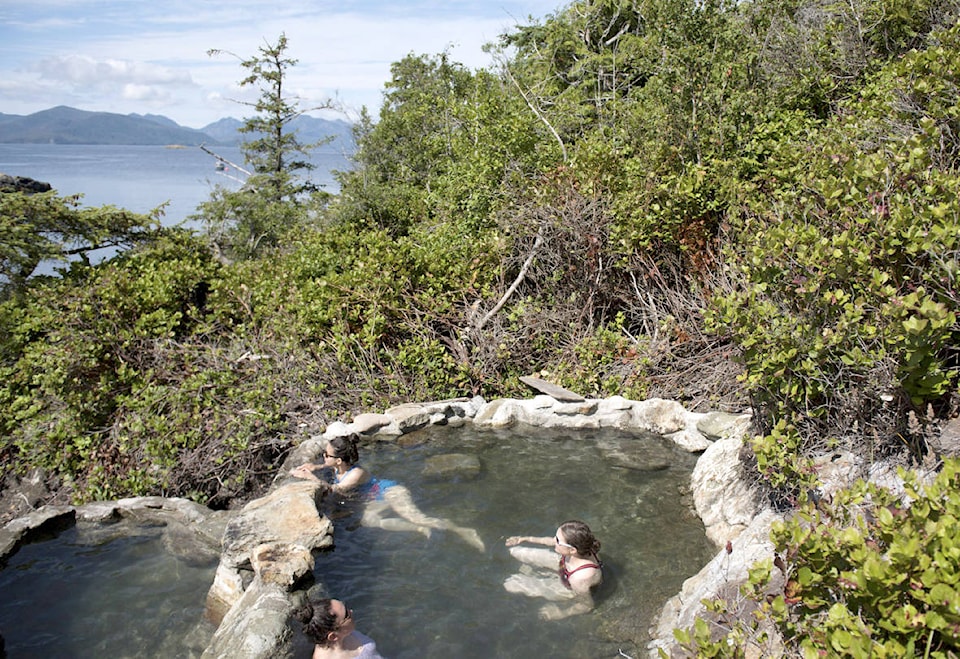Springs are heating up again on Hotspring Island / Gandll K’in Gwaayaay.
Before a major earthquake struck off the west coast of Haida Gwaii in October 2012, Hotspring boasted some of the steamiest springs in Canada, with temperatures reaching 77 C.
But for 10 weeks after the quake, the springs stopped. The thermal pools drained and went dry as anything can on Haida Gwaii.
By early 2013, Gwaii Haanas staff noticed some springs were beginning to flow again, and in the years since, several new ones have emerged at lower elevations, closer to the shore.
While the springs still aren’t as hot as they used to be — they now range from 34 to 62 C — a new study gives hope that the heat and flow will keep on rising.
“We know they’re still increasing,” says Patrick Bartier, a geomatics coordinator for Gwaii Haanas who co-authored the study with Stephen Grasby, a geochemist with the Geological Survey of Canada.
“I can’t put any timeline to it, but maybe next year or in a couple years, we can expand the pools and maybe open up some of the ones that existed before.”
Bartier and Grasby surveyed 13 springs and smaller seeps on Hotspring in August 2014, looking at their temperature, flow, and chemical make-up.
They also reviewed GPS data showing how Hotspring and surrounding islands shifted during the 2012 quake, and they studied drilling logs from several test wells dug for oil exploration on and around Haida Gwaii between 1913 and 1984.
Bartier said the earthquake data showed Hotspring and islands nearby sprung westward after the quake — a sudden shift that likely opened cracks and pores in the rock, allowing groundwater to drain further underground.
If the quake had instead blocked up channels in the rock, the hotsprings might never have come back. But the gradual appearance of lower, weaker springs suggest their source is gradually building up again.
“We don’t know where the source is,” Bartier said, but the best guess is the hotsprings start as rainwater collecting on the hills of nearby Ramsay Island, or possibly Lyell.
Besides heat, the main force that pushes the water up to the surface on Hotspring is water pressure — basically, as rainwater gathers high on Ramsay or Lyell, it builds enough pressure to force water up through channels in the rock until it spouts up on Hotspring, which is lower.
Based partly on the oil-drilling logs, which suggest temperatures naturally rise 32.6 C per kilometre under Haida Gwaii, Bartier and Grasby estimate that the hotsprings start at a maximum depth of 3.6 km.
They confirmed the estimate by looking at what types of minerals are dissolved in the spring water. Different minerals dissolve at different temperatures, so the water’s chemical signature can be used as a kind of “geothermometer” — for Hotspring, it shows the spring waters reach 117 C deep underground.
Besides the thermal pools that draw visitors — Gwaii Haanas built three new pools this year to capture water from the lower springs — they also have an effect on the island’s ecology.
“At this point, I don’t anticipate any major changes to the ecology, but we were really worried about that at first,” Bartier said, explaining that geothermal heat discourages spruce and cedar seedlings from taking over the shrubby, mossy, and lichen-rich area along Hotspring’s rocky west side.
While no one has done a formal study, salal berries seem to grow particularly well near the springs, possibly because they are warmed at the roots.
“The hummingbirds are amazing, too,” Bartier said, especially from May to June. “I’ve never seen hummingbirds like that anywhere else on Haida Gwaii.’
“It’s just buzzing with them, and it’s the salal berries.”
Bats are another high-flying resident of Hotspring — there is a maternal bat colony in the narrow cracks of the island’s shoreline cliffs, right by the pools.
“The bats don’t seem to have been affected at all,” Bartier said. “I think that’s because even when the water was completely gone, there was still heat rising up and warming the rocks.”
In fact, some of the hottest spring water emerges from just below the bat colony. Gwaii Haanas staff considered the area for a new pool, but decided against it for fear of disturbing the bats.
Besides the bats they were meant to see, wildlife cameras on Hotspring have captured images of another creature enjoying the island’s unique heat — otters like to lounge in one of the old cliff pools that is gradually filling up again.
“The sdllguu are regular visitors,” Bartier said.
